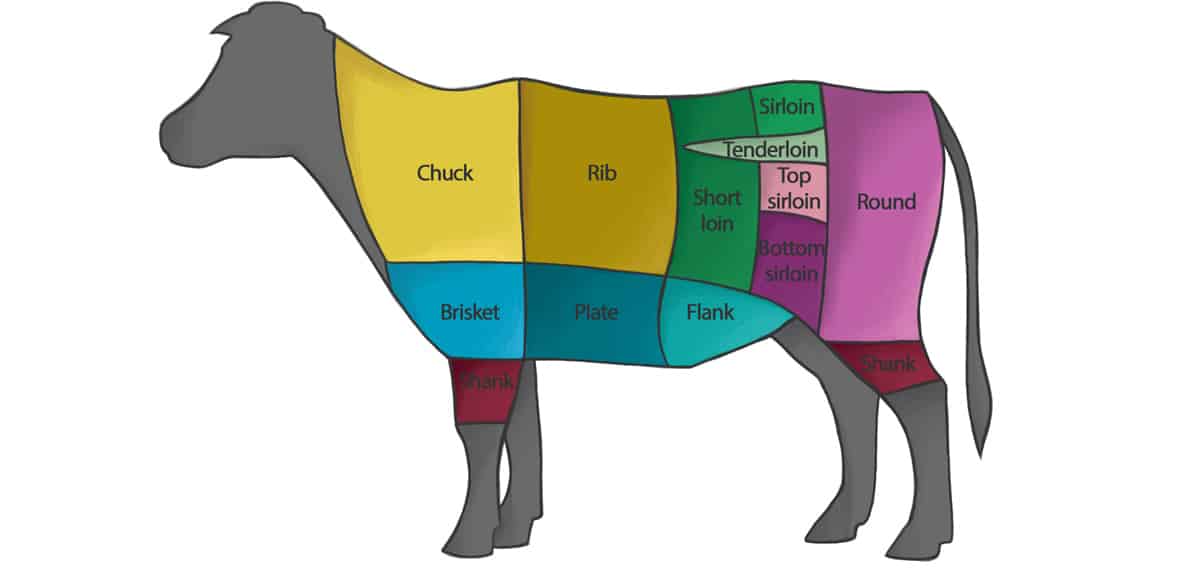First it was the Aussies; now it’s time for the UK: here’s a complete guide to finding Paleo grocery staples, translating American recipes, and more!

One common complaint from people trying to go Paleo in the UK is that it’s hard to find Paleo foods. What they usually mean by that is that it’s hard to find specialty foods, like grain-free flours and specific sweeteners.
But you don’t need those things to eat Paleo, and the base levels of the Paleo food pyramid are easy to find anywhere. Meat, fish, and eggs are available all around the world; so are vegetables and fresh fruits. If you have a specialty store that offers the less-basic ingredients, that’s great. You can also get them online. But nobody needs those foods to eat Paleo. Focus on the basics: fresh meat, fresh produce, and healthy fats. Don’t get hung up on tapioca starch and date paste!
Decoding Meat Labels: UK Edition
Even the basics might not seem so “basic” when you get into it, though. US-based Paleo followers make a big deal out of grass-fed organic meat, but all of those labels are specific legal terms that completely change meaning outside the US context. The UK has a whole different set of labels to learn
The good news is that the horror stories you hear from American websites might not even apply to the UK: EU animal welfare legislation is generally stricter for everyone, and some of the cruelest and most abusive factory-farm practices are just plain illegal. For example, almost all eggs in the US are laid by hens in battery cages, but in the EU, battery cages are forbidden across the board, so you don’t have to worry about finding a label for that.
It’s similar with beef: the US has huge amounts of land to grow soy and corn to feed to cows in feedlots, but the UK just doesn’t have that kind of space (for comparison, the land area of the entire UK is about 244,000 square kilometers. The land area of the state of Montana alone is 381,000 square kilometers, and Montana is just one of many agricultural states in the US). Ecologically, the UK just isn’t built for factory-farmed cows, so they never really took off and most meat leans toward the grass-fed end of the spectrum regardless of where you buy it.
The very best way to get meat in any country is to get it straight from a farmer. Then you can ask yourself about how the animals are treated; no need to rely on a label to summarize it according to someone else’s standards.
If you can’t get in touch with a farmer and you’re stuck with a grocery store, there are also a few labels to look for. One of the best is the Soil Association logo (it’s a black and white image that looks a little like a twisted triangle, with “SOIL ASSOCIATION” written on it), which indicates higher standard of animal welfare. Overall, the Soil Association logo came off the best in a recent Compassion in World Farming report. The report looked at pork, dairy, beef, sheep, poultry, eggs, and salmon, and SA was the only label that met gold or silver standards for almost all the types of food tested (with the exception of sheep, where no label got gold or silver).
You can also buy grass-fed, grass-finished meat from a variety of different online suppliers who will deliver it to your door. Many of these providers can give you a lot more information about the source of the meat than the typical supermarket labels.
In the UK, unlike the US, it’s also legal to buy game meat like rabbit and venison – that’s arguably more Paleo than domesticated animals anyway, and it frees you from worrying about farming practices completely.
Recipes and Cuts of Meat
Once you’ve bought your meat and vegetables, it’s time to cook them…which is when measurements rapidly become a problem. Most Paleo food and recipe blogs are written by people living in the US, so they’ll use US measurements.
Unfortunately, these can be hard to translate, because US recipes typically measure ingredients by volume, while UK recipes typically measure them by weight. Translating from cups, teaspoons, and tablespoons into grams depends on what you’re translating.
- In general, for thin liquids (vinegar, water, stock or broth, etc.), 1 cup = 200-250 grams.
- In general for fats and oils (olive oil, coconut oil, etc.), 1 cup = 215-230 grams. 1 tablespoon = 25-30 grams.
- 1 “stick of butter” in US English = 8 tablespoons = ½ a cup = just over 100 grams.
- For measuring vegetables, just use your fist. 1 cup is roughly a fist-sized amount.
Another question that you might have with American food blogs: what the heck is up with the cuts of meat? Translating meat cuts from US English into UK English is a minefield, because they’re not just different names for the same thing; they’re completely different ways of dividing up the animal. Pork and chicken aren’t so bad, but beef is notoriously complicated, especially steak.

Instead of trying to “translate” from one cut to the other, it makes more sense to think of how you want to use the beef in question, and then just find a cut that works well for that application.
| What kind of cut of beef do you want? | American English | British English (according to BBC Good Food) |
| Something that I’m going to braise slowly at a low temperature in a relatively large chunk (like this slow-cooked brisket, not in a soup or stew). | Chuck, brisket, shoulder, “_______ roast”, anything with “round” in it (“round roast,” “top round,” etc.), ribs | Brisket, topside, silverside. |
| Something that I’m going to roast. | “_______ roast” | Rib, sirloin, top rump, fillet |
| Something I’m going to quickly grill or pan-fry. | Any kind of steak (some are fattier than others) | Fillet, rib eye, sirloin, rump steak, entrecôte |
| Something with a bone in it for making savory soups and stews (like this one). | Oxtail, shank, leg, ribs | Oxtail, shin, bone-in ribs |
| Something to put in a stew, but without a bone in it. | Stewing beef, stew meat | Stewing or braising steak, shank |
| Something to make hamburgers, meatballs, etc. with. | “Ground beef” or "hamburger meat" | “Beef mince” or "minced beef" |
Organ meats, thankfully, have the same names: a liver is a liver and a tongue is a tongue regardless of which side of the Atlantic you’re on.
Most recipes will work just fine with a slightly different cut; it’s hard to imagine a set of directions so particular that you couldn’t substitute a slightly different type of roast and still get tasty results. Steak is tricky, but a good method is just to use your judgement for what kind of steak you would use for that particular preparation and not sweat the details of the name. It can be fun in a way to nerd out over all the different types of muscle that one cow can provide, but it’s really not necessary if you know what you like and trust your own judgement.
Summing it Up
Dealing with American recipe blogs and sites can be a pain if you don’t use Imperial measurements and all your cuts of meat are different. But with a little ingenuity it's completely possible to figure out what works and what doesn't; think about "what cut of beef would I use for this recipe" more than "what's the specific equivalent of __________". Hopefully as more and more people outside the US start getting interested in Paleo, we’ll start seeing specialty foods become more available, and more great UK-based Paleo recipes where you don’t have to translate at all.





Leave a Reply